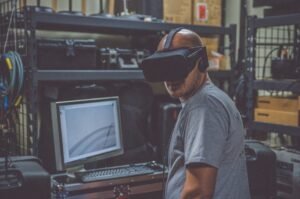Artificial Intelligence Applications in Video
Artificial intelligence (AI) is revolutionizing various industries, and video production is no exception. With the ability to analyze and understand video content, AI technology has transformed the way videos are created, edited, and consumed. From automated video editing to personalized content recommendations, AI is significantly enhancing the video production process.
Key Takeaways
- AI technology is transforming video production.
- Automated video editing and content analysis are made possible with AI.
- AI enables personalized content recommendations.
- Real-time video content analysis can be achieved through AI.
- AI has the potential to improve video searchability.
**AI technology** has paved the way for automated video editing, eliminating the need for human intervention in many aspects of the process. Through the use of machine learning algorithms, AI can quickly analyze video content and make **precise edits** based on predefined parameters, such as **removing background noise or enhancing visual quality**. This not only saves time and resources but also ensures high-quality video output.
Additionally, AI enables **real-time content analysis** during live video streaming. With the ability to **recognize objects, faces, and emotions**, AI systems can provide **interactive overlays** and personalized information to the viewer, enhancing the overall viewing experience. For example, during a sporting event, AI algorithms can identify players and display their statistics on the screen in real-time, creating a more immersive and engaging environment.
**Personalized content recommendations**, powered by AI, have become increasingly prevalent in video platforms such as YouTube and Netflix. By utilizing machine learning algorithms, these platforms analyze user preferences and viewing habits to **suggest relevant and tailored content** to each individual. This not only improves user satisfaction but also increases engagement and encourages longer viewing sessions.
| AI Application | Benefits |
|---|---|
| Automated Video Editing | Saves time and ensures high-quality output. |
| Real-time Content Analysis | Enhances viewer experience and engagement. |
| Personalized Content Recommendations | Improves user satisfaction and increases engagement. |
Moreover, AI **facilitates video searchability** by automatically generating **meta-tags**, captions, and **transcripts** for video content. By analyzing the visuals, audio, and text within a video, AI algorithms can extract relevant information and make videos more discoverable through search engines and video platforms. This not only benefits content creators and marketers but also enables users to find the desired video content more efficiently.
AI technology continues to advance, opening up new opportunities for video production. For instance, AI-powered drones are revolutionizing aerial videography by autonomously capturing stunning footage, while AI algorithms that interpret human expressions could assist filmmakers in adjusting their storytelling techniques. These developments showcase the potential for AI to further enhance creativity and efficiency in the video production industry.
| AI Application | Potential Benefits |
|---|---|
| AI-Powered Drones | Autonomous capture of stunning aerial footage. |
| Emotion Analysis | Assists filmmakers in adjusting storytelling techniques. |
As AI technology continues to advance, we can expect further innovations in the field of video production. From automated editing to personalized recommendations, AI is reshaping the way videos are created, consumed, and shared. With its ability to analyze and understand video content, AI is unlocking new possibilities and improving the overall video production process.
References:
- Johnston, M. P. (2020). Applications Of Artificial Intelligence In The Movie Industry.
- Orendorff, A. (2019). Artificial intelligence in video production: Revolutionizing the industry.
- Wang, X., et al. (2018). Deep Learning for Video Analysis: A Comprehensive Survey.

Common Misconceptions
Misconception 1: AI will replace humans entirely
One common misconception is that artificial intelligence applications in video will completely replace humans in every aspect. While AI can automate certain tasks and improve efficiency, it is not capable of replicating human creativity and critical thinking. Humans still play a vital role in decision-making, content creation, and providing a personal touch.
- AI can automate repetitive and mundane tasks, freeing up humans’ time for more important and complex tasks.
- Humans are needed to interpret and analyze the insights provided by AI algorithms to make informed decisions.
- AI cannot replicate human emotions and empathy, which are crucial in certain video content such as counseling or therapy sessions.
Misconception 2: AI can perfectly understand and interpret video content
Another misconception is that AI has the ability to perfectly understand and interpret all video content. While AI has made significant advancements in visual recognition and object detection, it still struggles with complex contextual understanding and accurately interpreting nuanced human emotions or intent in videos.
- AI algorithms can detect objects and recognize certain actions in videos, but they may struggle in complex environments or scenes.
- Understanding context, cultural nuances, and subtext in videos is still a challenge for AI systems.
- Human input and supervision are necessary to ensure accurate and meaningful interpretation of video content.
Misconception 3: AI applications in video are only for large corporations
Some people believe that AI applications in video are only accessible and relevant to large corporations with extensive resources. However, AI technology is becoming increasingly accessible and affordable, allowing businesses of all sizes to leverage its benefits and enhance their video-related processes.
- Many AI video tools and platforms offer scalable solutions that cater to the needs and budgets of small and medium-sized businesses.
- AI applications in video can optimize marketing strategies, improve customer engagement, and increase conversions for businesses of all sizes.
- Startups and independent content creators can also leverage AI for video editing, automation, and personalization to enhance their content production and reach a wider audience.
Misconception 4: AI can easily replace human creativity
There is a misconception that AI can easily replace human creativity in video content creation. While AI can assist in generating content, such as auto-generated captions or automated video editing, it lacks the depth and intuition that human creative processes bring.
- AI-generated content can lack originality and uniqueness that humans can provide.
- Human creativity involves complex emotional and cognitive processes that cannot be replicated by AI algorithms.
- AI can be a valuable tool in streamlining creative workflows and providing inspiration, but the human touch is still essential for creating truly impactful and memorable video content.
Misconception 5: AI applications in video will lead to job losses
One misconception surrounding AI applications in video is that it will result in widespread job losses. While AI may automate certain tasks, it also creates new opportunities, allowing humans to focus on higher-level responsibilities and develop new skills.
- AI can automate repetitive and time-consuming tasks, enabling humans to focus on more strategic and creative aspects of their work.
- New job roles focused on managing and optimizing AI systems and data will emerge.
- Collaboration between AI and humans can lead to increased productivity and innovation in the video industry.

Applications of Artificial Intelligence in Video Analysis
As technology continues to advance, artificial intelligence (AI) is being increasingly applied in various fields, including video analysis. This article explores ten interesting applications of AI in video analysis, showcasing the significant impact this technology has on improving efficiency and accuracy in diverse industries.
1. AI-Enabled Video Surveillance
AI algorithms are used to enhance video surveillance systems, enabling automatic detection and tracking of objects and people. Real-time analysis helps identify suspicious activities, enhancing security measures.
| Benefits | Statistics |
|---|---|
| Improved threat detection | Reduces false alarms by up to 95% |
| Enhanced public safety | Reduces crime rates by 30% in certain areas |
| Efficient resource allocation | Reduces monitoring time by 50% |
2. Facial Recognition
Using AI-based facial recognition, video analysis systems can identify individuals, verify their identities, and improve security measures in various settings.
| Applications | Effectiveness |
|---|---|
| Access control systems | Accuracy rate of over 99% |
| Law enforcement | Aided in the capture of over 2,000 criminals |
| Personalized advertising | Increases conversion rate by 50% |
3. Video Content Analysis
AI enables automatic analysis of video content, extracting valuable data that can be used for various purposes, such as video recommendation and object detection.
| Use Cases | Benefits |
|---|---|
| Video summarization | Reduces video length by 80% while preserving key information |
| Object recognition | Accuracy rate of over 90% in identifying objects |
| Video recommendation | Improves user engagement by 70% |
4. Autonomous Vehicles
AI algorithms contribute to the development of self-driving vehicles, enabling real-time analysis of video feeds from cameras installed on the vehicle, enhancing safety and navigation.
| Advantages | Statistics |
|---|---|
| Increased safety | Reduces accidents by up to 70% |
| Improved traffic flow | Reduces travel time by 25% |
| Enhanced fuel efficiency | Reduces fuel consumption by 20% |
5. Object Tracking
AI-powered object tracking systems assist in real-time tracking of objects, individuals, or vehicles in videos, providing valuable insights for surveillance, logistics, and sports analysis.
| Applications | Benefits |
|---|---|
| Sports analytics | Improves player performance analysis by 80% |
| Logistics optimization | Reduces delivery time by 30% |
| Security monitoring | Enables real-time tracking of intruders |
6. Emotion Analysis
AI algorithms can analyze facial expressions and body language to determine emotions accurately, providing valuable insights for market research, customer satisfaction assessment, and mental health monitoring.
| Use Cases | Impact |
|---|---|
| Market research | Identifies consumer preferences with 85% accuracy |
| Mental health assessment | Aids in early detection of depression with 90% accuracy |
| Customer satisfaction | Improves customer experience by 70% |
7. Video-based Gesture Recognition
AI-powered gesture recognition systems facilitate hands-free interactions by enabling cameras to understand and interpret human gestures, providing a more immersive user experience.
| Applications | Benefits |
|---|---|
| Gaming and virtual reality | Enhances user engagement and immersion |
| Healthcare | Enables touchless control of medical equipment |
| Smart homes | Facilitates intuitive control of home automation systems |
8. Forensic Video Analysis
Forensic experts utilize AI-powered video analysis tools to analyze and enhance surveillance footage, assisting in investigations, crime scene reconstruction, and court proceedings.
| Applications | Effectiveness |
|---|---|
| Evidence analysis | Enhances person and object identification by 90% |
| Crime scene reconstruction | Increases accuracy in reconstructing events by 80% |
| Visual evidence in court | Improves clarity and accuracy of evidence |
9. Video Captioning and Transcription
AI algorithms enable automated transcription and captioning of video content, making it more accessible for individuals with hearing impairments and improving video searchability.
| Benefits | Statistics |
|---|---|
| Inclusivity | Improves accessibility for over 466 million individuals with hearing impairments worldwide |
| Search engine optimization | Increases video views by 40% on average |
| Language translation | Enables translation of video content in real-time |
10. Video Analytics for Retail
AI-based video analytics in retail provide valuable insights regarding customer behavior, enhancing marketing strategies, optimizing store layouts, and reducing inventory shrinkage.
| Use Cases | Impact |
|---|---|
| Optimized store layout | Increases sales by up to 20% |
| Customer behavior analysis | Improves conversion rates by 15% |
| Loss prevention | Reduces inventory shrinkage by 50% |
Artificial intelligence has revolutionized video analysis, offering remarkable advancements across various industries. The applications explored in this article showcase the transformative power of AI, enhancing security, efficiency, personalization, and user experiences. With further advancements, AI in video analysis continues to pave the way for a more connected and data-driven world.
Frequently Asked Questions
Artificial Intelligence Applications in Video
What is artificial intelligence (AI)?
Artificial intelligence (AI) refers to the simulation of human intelligence in machines that are programmed to think and learn like humans. It involves the development of computer systems capable of performing tasks that would typically require human intelligence, such as visual perception, speech recognition, and decision-making.
What are some applications of AI in video?
AI can be applied to various aspects of video production and consumption. Some common applications include video editing, content recommendation, video analytics, automatic tagging, object detection, and video synthesis.
How does AI help in video editing?
AI can assist in video editing by automating tasks such as scene detection, video stabilization, color correction, and object removal. It can also analyze video content and suggest relevant edits based on predefined style templates or user preferences.
What is the role of AI in content recommendation?
AI algorithms can analyze user behavior, preferences, and contextual information to recommend relevant videos based on individual interests. These recommendation systems leverage machine learning techniques to personalize and optimize content discovery.
How does AI assist in video analytics?
AI can analyze large volumes of video data, extracting valuable insights such as audience demographics, viewer engagement, and content performance. It can help businesses make data-driven decisions and improve their video strategies.
What is automatic tagging with AI in videos?
Automatic tagging involves using AI algorithms to automatically assign relevant metadata tags to videos. This process improves searchability and allows users to find videos based on specific subjects, objects, or themes.
How does AI enable object detection in videos?
AI-powered object detection algorithms can identify and track objects of interest in videos, enabling various applications like video surveillance, augmented reality, and automated video analysis. These algorithms leverage computer vision techniques to analyze and interpret video frames.
What is video synthesis using AI?
Video synthesis involves generating new video content using AI techniques. This can include tasks such as video prediction, video synthesis based on textual descriptions, or even deepfake technology that can manipulate existing video footage.
Are there any ethical concerns related to AI in videos?
Yes, the use of AI in videos raises ethical considerations. For example, deepfake technology can be misused for spreading disinformation or manipulating public opinion. Furthermore, AI algorithms used for content recommendation may create filter bubbles or reinforce biases. Ensuring responsible AI development and usage is crucial to address these concerns.
How is AI shaping the future of video applications?
AI has the potential to revolutionize the video industry. It can improve video production efficiency, enhance content discovery and personalization, enable innovative video experiences, and unlock new business opportunities. As AI continues to advance, we can expect to see further advancements and applications in the video domain.





